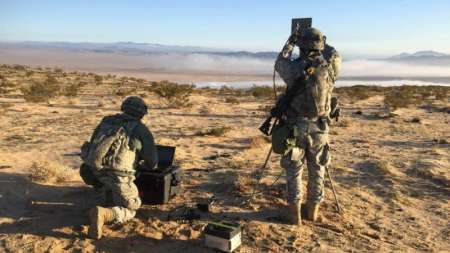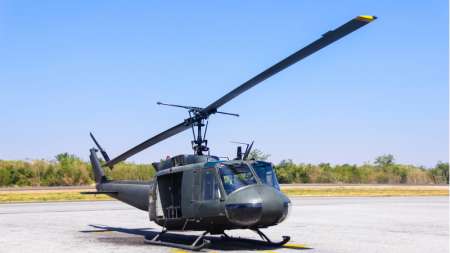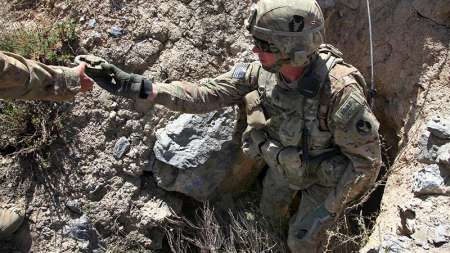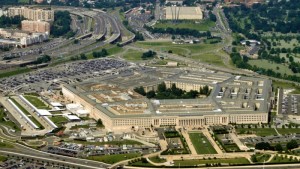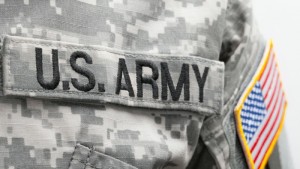Pentagon leaders say they’re serious about getting ahead in the artificial intelligence (AI) game, which increasingly could include the “games” involved in the modeling and simulation programs used for training. […]
Sometime in May, the Army will take two armed, autonomous Humvees out onto a gunnery range to test and certify them as combat vehicles, which will make them the first robotic ground vehicles to be OK’d for combat. […]
The idea of a scorecard seems like a quaint notion, conjuring black and white photos of somebody’s grandad in a fedora, licking the pencil tip before recording the latest play at the old ballgame in his program. […]
The Army’s work on the Internet of Battlefield Things (IoBT) is more than just a way to carve out a catchy name for the proliferation of smartphones, tablets, wearable devices, cameras and embedded devices that take the field with military forces. It also underscores the most important element of having those connected devices–the data collection and automated analytics capabilities required to make good use of the information they provide. […]
A lot of the Army’s most high-profile modernization projects concern complex, expensive weapons systems that emerge from research and development, budgeting, and procurement process inside the halls of the Pentagon and other facilities and outside of the experience of most people. But some key elements of the Army’s efforts to keep pace with the demands of a changing world are so familiar to people at home, at work, or in a coffee shop that they take them for granted. An example of this is good, reliable Wi-Fi. […]
The military’s use of unmanned, and even semi-autonomous aircraft has been extensive, but no one’s ever pretended that it would be as easy as point-and-click. That day could be getting closer however, as the Marine Corps recently demonstrated how autonomous helicopter flights could clear a few final hurdles and move towards more widespread military use. […]
After years on the backburner, electronic warfare (EW) is moving up the ranks as an integral part of the Pentagon’s military focus. The Army last month received approval to move ground-based EW efforts into the Terrestrial Layer Intelligence System, joining cyber, signals, and other intelligence as part of the Multi-Function Electronic Warfare (MFEW) structure. The service wants to include airborne EW later this year. […]
With the Internet for transportation, a lie can get all the way around the world before truth can blink itself awake. And that’s a challenge for those who seek to stem the proliferation of false information, be it accidentally misattributed quotes, political propaganda, or malicious “fake news.” Artificial intelligence can help combat the problem, by using machine learning algorithms to detect the patterns used in phony stories and ads designed to stir up fear or outrage, or, in the case of Russian disinformation, unsettle people’s faith in American institutions. […]
The Army and Navy recently announced that their Cyber Mission Teams were fully operational, and the U.S. Cyber Command now has all of their planned complement of 133 teams in business. With its people (totaling more than 6,000 service members and civilians) in place, U.S. cyber forces can now look to machines to help carry out effective operations in the cyber domain. […]
The Department of Defense (DoD) is cooking up big plans for blockchain technology, the digital ledger best known for its support of cryptocurrencies such as Bitcoin and Ethereum. The technology’s decentralized, encrypted approach holds promise for a variety of secure functions in addition to financial transactions, from cyber defense and distributed communications to protecting the digital supply chains used by deployed forces for 3D printing. A Navy officer on the Naval Innovation Advisory Council has written that blockchain could “revolutionize” the way military operations over the next decade. […]
MeriTalk compiles a weekly roundup of contracts and other industry activity. Here’s what happened this week in the Federal Information Technology community. […]
The Army’s cyber soldiers in the 17C military occupational specialty are highly likely to stay on for their entire first term of service, but they are far less likely to re-enlist after the first term, according to a recent RAND Corp. study. […]
Military bases operate like their own towns and cities, and should be considered partners in smart city initiatives, according to Richard Kidd, deputy assistant secretary of the Army, who spoke at the Global City Teams Challenge Expo. “The Army runs 156 towns across America and every day more than 2 million people go to work inside those towns and cities that are Army installations,” said Kidd. “We are facing many of the challenges that you are facing.” […]
As the U.S. military shifts its focus to Europe and Asia, the cyber dominance the Army enjoyed in Afghanistan and Iraq may no longer be assured, according to a recently released Army field manual. […]
James Madison University students are working with the Hacking for Defense (H4D) program, funded by the Department of Defense, in order to build the technologies that the military needs. […]
IBM has been awarded a cloud solution contract by the U.S. Army potentially worth $62 million over five years, to build, manage, and operate a cloud for the Army’s Redstone Arsenal. […]
The Department of Defense announced two initiatives based on the past success of Hack the Pentagon and aimed at increasing vulnerability reporting opportunities: a Vulnerability Disclosure Policy and Hack the Army. […]
DISA has recently acquired $9.7 million from the DoD Office of Small Business Programs (OSBP) to fund innovative technologies. […]
The Department of Defense continues to push forward with efforts to bolster its IT system. The Army awarded a $5 billion Information Technology Enterprise Solutions 3 Hardware contract for IT hardware, software, and other services, to 17 companies. […]
The market for virtual reality headsets—like the popular gaming system known as Oculus Rift, or the many headsets that are now shipping with consumer drones—is poised for rapid growth starting this holiday season. In fact, Juniper Research estimates that global sales of VR headsets will hit 3 million next year and as much as 30 […]




